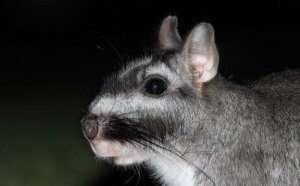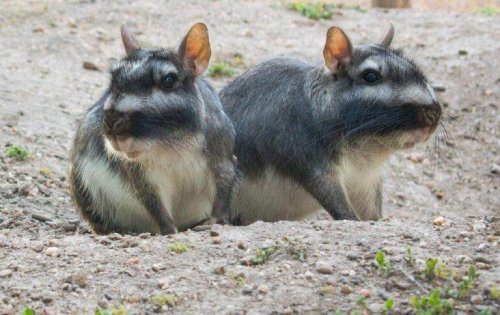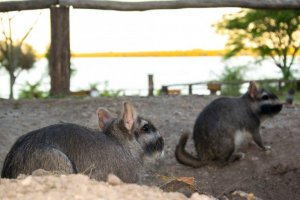Meet the Common Viscacha

Lagostomus maximus is the scientific name for the so-called viscacha, a large rodent that lives in some areas of South America. They have gregarious habits and have a wide repertoire of voices they use to communicate.
The only living species of its kind
Also known as the viscacha of the plains, it’s the only living species from the Lagostomus genus. It’s part of the Chinchillidae family.
However, it’s worth noting that viscacha — a Quechua name — is also used for 4 other rodent species:
- The Cariamanga Viscacha (Lagidium sp.). Found in Ecuador.
- The northern mountainous viscacha (Lagidium peruanum). Lives in Peru.
- The southern mountainous viscacha (Lagidium viscacia). They’re spread throughout the southern regions of Peru, Bolivia, Chile, and west Argentina.
- Orange mountainous viscacha (Lagidium wolffsohni). Lives in the south of Argentina and Chile.
Anyway, instead of overwhelming you with so many details, we’re only going to talk about the common viscacha.
Let’s look at the common viscacha, a large rodent that lives in South America.

Traits of Lagostomus maximus
This South American rodent has a sturdy and round body that can reach up to 65 cm in length. They have short front legs and four fingers with thick nails that they use to dig.
They also stand out because they have a black stripe across their face that begins at their snout and crosses their cheeks. This separates the lower white part (around the mouth) from the upper white band that’s around his eyes.
Other traits of the common viscacha are:
- Bulky head
- Large eyes
- Medium-size ears that are wide at the base and narrow at the tips.
- Short snout with long, black and tough whiskers.
- Strong hind legs that are longer than their front legs. They have three fingers with long claws.
- Short, hairy and curved tail.
- Short, soft and silvery gray to brownish-gray fur. They also have cream-colored fur and their bellies are white.
- Males are larger than females and weigh an average of five and a half kilos. Also, their head is more robust and their face is more contrasted.
The common viscacha’s habitat and diet
This rodent lives in the grasslands and shrub prairies. They can be found at up to 1900 meters of elevation. Also, they form colonies of up to 50 individuals in which they peacefully coexist, except during mating season.
There are between one and three adult males in each of these colonies while the rest are females and young viscacha. However, they don’t tolerate members of other groups.
They live in burrows that they make by digging with their front legs. These burrows have tunnels that connect to each other. These shelters have several exits and can reach up to 700 square meters.
When the sun goes down, the viscachas leave their burrows to feed. However, it usually won’t go far from the shelter. Their diet is made up of herbs, shrubs, and seeds.

More details about this South American rodent
The females go into heat during the fall. That’s when the males get into violent fights with one another. Once they find a mate, they mate inside their burrow. Then, after about five months of gestation, two babies are born that weigh around 200 grams.
Males reach sexual maturity at the age of one and a half. At that time, the young tend to leave the shelter and dig their own homes.
The females — who sexually mature between eight months and a year — stay in the colony they were born into.
A species hunted for their flesh and hides
With a life expectancy between seven and eight years, the common viscacha doesn’t have any serious conservation problems in most of the areas they live.
However, in certain places, they have begun to disappear due to overhunting. They are sought after for their hides and delicious meat, which is marinated.
Floods are also another reason why they are disappearing. In some regions, people try to fight them off because they cause great losses in agriculture.
Lagostomus maximus is the scientific name for the so-called viscacha, a large rodent that lives in some areas of South America. They have gregarious habits and have a wide repertoire of voices they use to communicate.
The only living species of its kind
Also known as the viscacha of the plains, it’s the only living species from the Lagostomus genus. It’s part of the Chinchillidae family.
However, it’s worth noting that viscacha — a Quechua name — is also used for 4 other rodent species:
- The Cariamanga Viscacha (Lagidium sp.). Found in Ecuador.
- The northern mountainous viscacha (Lagidium peruanum). Lives in Peru.
- The southern mountainous viscacha (Lagidium viscacia). They’re spread throughout the southern regions of Peru, Bolivia, Chile, and west Argentina.
- Orange mountainous viscacha (Lagidium wolffsohni). Lives in the south of Argentina and Chile.
Anyway, instead of overwhelming you with so many details, we’re only going to talk about the common viscacha.
Let’s look at the common viscacha, a large rodent that lives in South America.

Traits of Lagostomus maximus
This South American rodent has a sturdy and round body that can reach up to 65 cm in length. They have short front legs and four fingers with thick nails that they use to dig.
They also stand out because they have a black stripe across their face that begins at their snout and crosses their cheeks. This separates the lower white part (around the mouth) from the upper white band that’s around his eyes.
Other traits of the common viscacha are:
- Bulky head
- Large eyes
- Medium-size ears that are wide at the base and narrow at the tips.
- Short snout with long, black and tough whiskers.
- Strong hind legs that are longer than their front legs. They have three fingers with long claws.
- Short, hairy and curved tail.
- Short, soft and silvery gray to brownish-gray fur. They also have cream-colored fur and their bellies are white.
- Males are larger than females and weigh an average of five and a half kilos. Also, their head is more robust and their face is more contrasted.
The common viscacha’s habitat and diet
This rodent lives in the grasslands and shrub prairies. They can be found at up to 1900 meters of elevation. Also, they form colonies of up to 50 individuals in which they peacefully coexist, except during mating season.
There are between one and three adult males in each of these colonies while the rest are females and young viscacha. However, they don’t tolerate members of other groups.
They live in burrows that they make by digging with their front legs. These burrows have tunnels that connect to each other. These shelters have several exits and can reach up to 700 square meters.
When the sun goes down, the viscachas leave their burrows to feed. However, it usually won’t go far from the shelter. Their diet is made up of herbs, shrubs, and seeds.

More details about this South American rodent
The females go into heat during the fall. That’s when the males get into violent fights with one another. Once they find a mate, they mate inside their burrow. Then, after about five months of gestation, two babies are born that weigh around 200 grams.
Males reach sexual maturity at the age of one and a half. At that time, the young tend to leave the shelter and dig their own homes.
The females — who sexually mature between eight months and a year — stay in the colony they were born into.
A species hunted for their flesh and hides
With a life expectancy between seven and eight years, the common viscacha doesn’t have any serious conservation problems in most of the areas they live.
However, in certain places, they have begun to disappear due to overhunting. They are sought after for their hides and delicious meat, which is marinated.
Floods are also another reason why they are disappearing. In some regions, people try to fight them off because they cause great losses in agriculture.
All cited sources were thoroughly reviewed by our team to ensure their quality, reliability, currency, and validity. The bibliography of this article was considered reliable and of academic or scientific accuracy.
Ledesma, K. J., Werner, F. A., Spotorno, A. E., & Albuja, L. H. (2009). A new species of mountain viscacha (chinchillidae: Lagidium meyen) from the Ecuadorean andes. Zootaxa.
Branch, L. C., Villarreal, D., & Fowler, G. S. (1994). Factors influencing population dynamics of the plains viscacha (Lagostomus maximus, Mammalia, Chinchillidae) in scrub habitat of central Argentina. Journal of Zoology. https://doi.org/10.1111/j.1469-7998.1994.tb01580.x
This text is provided for informational purposes only and does not replace consultation with a professional. If in doubt, consult your specialist.








